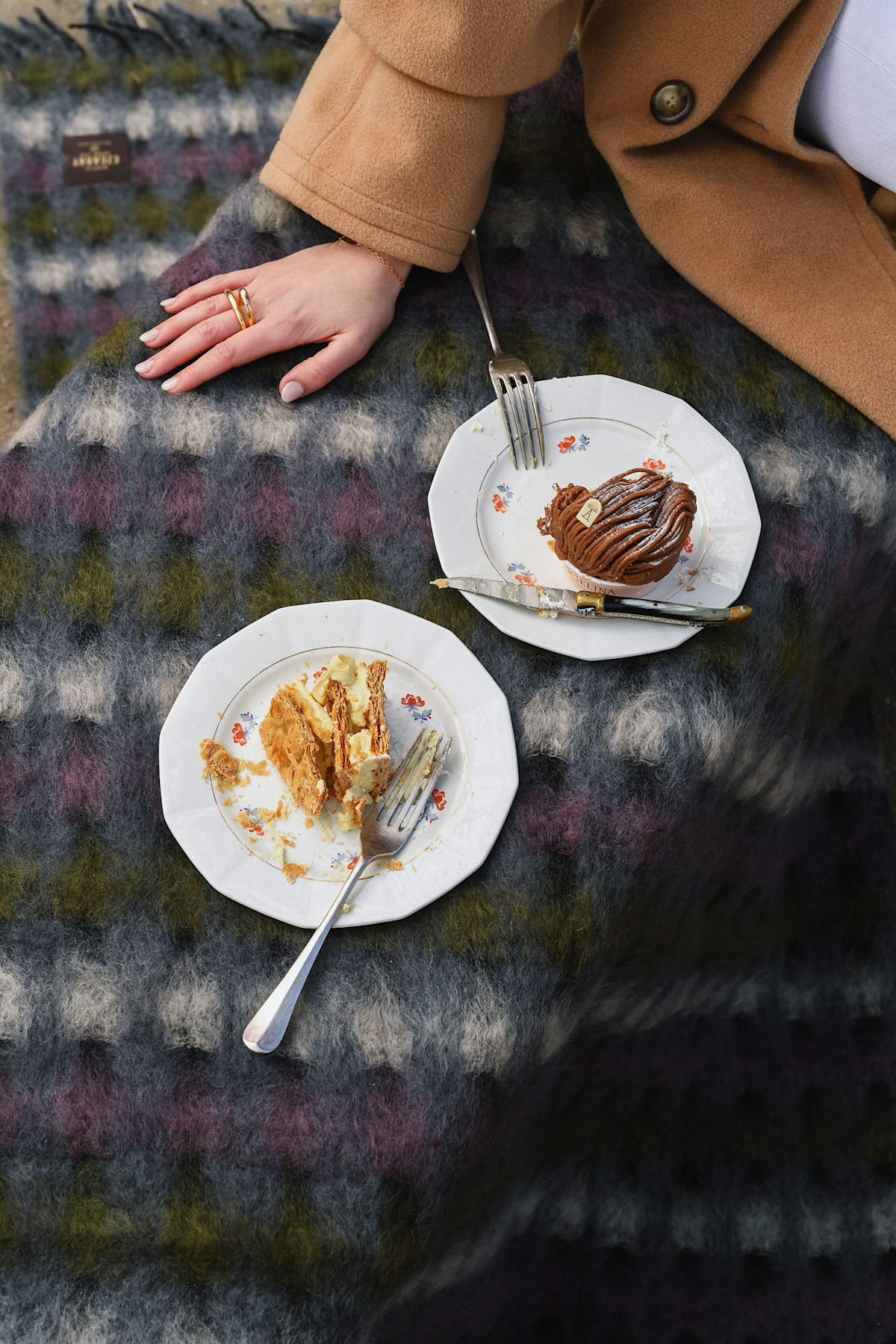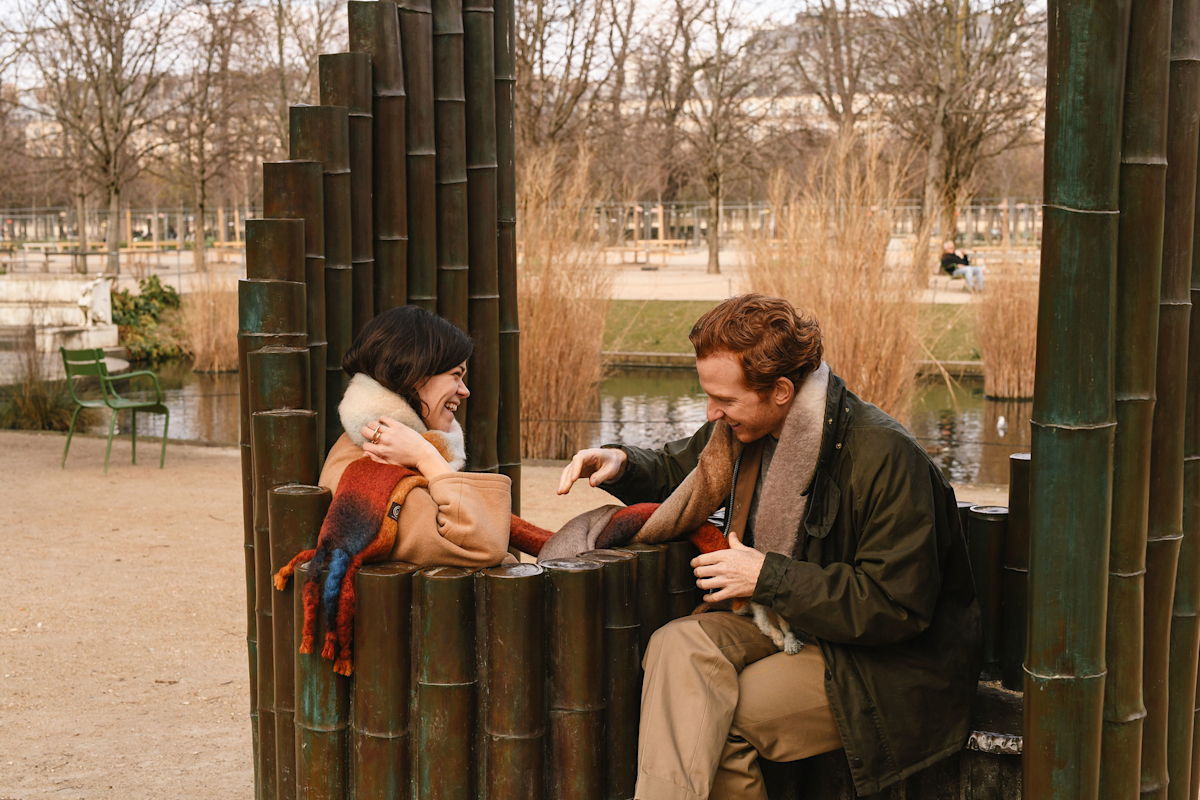
The Ezcaray
A World of Colour and Warmth
Words by Marc Richardson
Photography by Celia Spenard-Ko
A World of Colour and Warmth
A legacy of mohair with Ezcaray.
Words by Marc Richardson
Photography by Celia Spenard-Ko

The Ezcaray Matisse Throw M-14 at the Tuileries Gardens in Paris.
Juan Luis Valgañón was wearing a mask and speaking Spanish—which I don’t understand—through a translator. Yet, despite that, I have never seen anyone quite as enthusiastic and passionate as Juan Luis is about mohair.
“Tell him about the mohair,” he interjected as Ignacio Valgañón Iriarte began translating what he had said, eager for his nephew to get to the part about Mantas Ezcaray’s most famous product. Even I, sitting thousands of kilometres away, unable to see his smile or understand much of what he was saying, understood just how much mohair meant to Juan Luis. “My uncle particularly loves our mohair products,” Ignacio relayed, a smile audible in his voice, “because there’s nothing else in the world quite like them.”
Juan Luis is the CEO of Mantas Ezcaray, a company his father founded in 1930; Ignacio is part of the third generation to get into the family business, having joined last year. It stands to reason, then, that they’d think highly of their mohair.
But so does everybody else.

Marion drapes the Picasso Throw over her on a fresh Spring day.
Beyond just mohair, Mantas Ezcaray’s scarves, blankets, and other goods are world-renowned. Loewe, royalty in the world of luxury goods, has turned to Mantas Ezcaray to make its mohair products since the 1950s; King Felipe VI, Spanish royalty proper, recognized Mantas Ezcaray’s excellence in 2015; more importantly, pieces made on the Valgañón family’s looms in the small town of Ezcaray have made their way beyond La Rioja, first to other parts of Spain, then to France, to Canada, and to homes around the world.
“It is a special feeling,” Juan Luis says through Ignacio when asked about receiving recognition from the King—but also when asked what it feels like for his family to make something that’s cherished by another family, perhaps thousands of kilometres away.
They are two sides of the same blanket—a warm one at that. That warmth is what has endeared Mantas Ezcaray to so many.
On the one hand, it’s a warmth that’s familiar—the one that you can feel on your skin when running your hand against a delicately soft, plush blanket. Ezcaray is a unique place in that, in a country renowned for its warm weather, it’s the closest town to the ski resort of Valdezcaray. It’s a chilly place, where warm wares are appreciated. When Cecilio Valgañón founded what would become Mantas Ezcaray, the fine fibres he used could be found in Spain—on well-covered sheep and goats that migrated through the Oja Valley. As the years went on, he sourced them from England and France. It’s no longer possible to find the large quantities of high-end fibres that Mantas Ezcaray require close to home, but rather than settle for an inferior product, the Valgañóns’ work with some of the world’s finest materials, imported from as far away as South Africa.
“My father wanted to give the people some color—to bring life.”
On the other hand, it’s a warmth that’s hard to describe—the kind that you feel inside. It’s a warmth that radiates from the knowledge that something is the product of generations of a family’s know-how, passion and craftsmanship. A warmth that you feel coursing you through you when you see Mantas Ezcaray’s vibrant colors—colors which are an integral part of the company. When Cecilio launched his business, in the 1930s, it was a time when “everything was grey and sad,” explains Juan Luis, with Spain emerging from a period of war. “My father wanted to give the people some color—to bring life.”
Almost a century later, those colors have taken on a life of their own. Of course, that wouldn’t be possible without the Valgañóns’ commitment to making Mantas Ezcaray sustainable.
By sourcing their materials from suppliers in South Africa, Mongolia and Peru—and paying the premium that comes with the finest natural fibres in the world—Mantas Ezcaray has helped support small, independent farmers. In turn, those suppliers overwhelmingly employ better, more ethical practices when it comes to harvesting their wool: the animals roam free and are cared for, when needed, by veterinarians, not just because healthy animals live longer and produce better quality materials but also because it’s the right thing to do; reducing waste is environmentally-friendly, but it also makes an outsized difference for small-scale suppliers, for whom every last ounce of fibre is important.

The Mia Throw doubles as a picnic blanket.
It may seem self-evident, but there’s a symbiotic relationship that allows Mantas Ezcaray and its suppliers to thrive—and to leave something for the next generation.
Even as Mantas Ezcaray has grown and gained fans the world over, it remains a small, family-run operation with a focus on its immediate community. Ezcaray is a town with a rich history in textile production, but Mantas Ezcaray is now the lone company keeping that tradition alive; the townspeople have generations of expertise, which allows Mantas Ezcaray to continue to make their goods by hand. It’s with good reason, then, that the company changed names, eschewing the family name for that of the town it calls home—an homage to a place that’s home to fine cuisine and finer craftspeople. A place that, while physically cold, has a warmth about it that gets into your bones.
Just like the colorful mohair that Juan Luis loves so much.

Marion and James all wrapped up in the Tie Dye Scarf - TD 3B and Tie Dye Scarf - TD 2B

Marc is a writer and photographer. His work focuses primarily on fashion, culture, and the intersection between the two. He has spent the better part of the last decade cataloguing menswear from New York and London to Florence and Paris.

About Marc Richardson
Products in this story
More Good Stories
Kashiwa Craft: Shaped by Hand, Guided by Nature
Miyuki and Hisato Iwatsuki on carrying Seto’s legacy forward with warmth.
Rooted in Craft, Connected by Purpose: A Collaboration with EarthSeed Farm
From Clay to Craft: Inside the World of Bergs Potter
Giving Old Toys New Life: The Sustainable Vision of ecoBirdy
As one of the innovative maker partners in our community, ecoBirdy demonstrates that sustainability and design excellence can go hand in hand.































